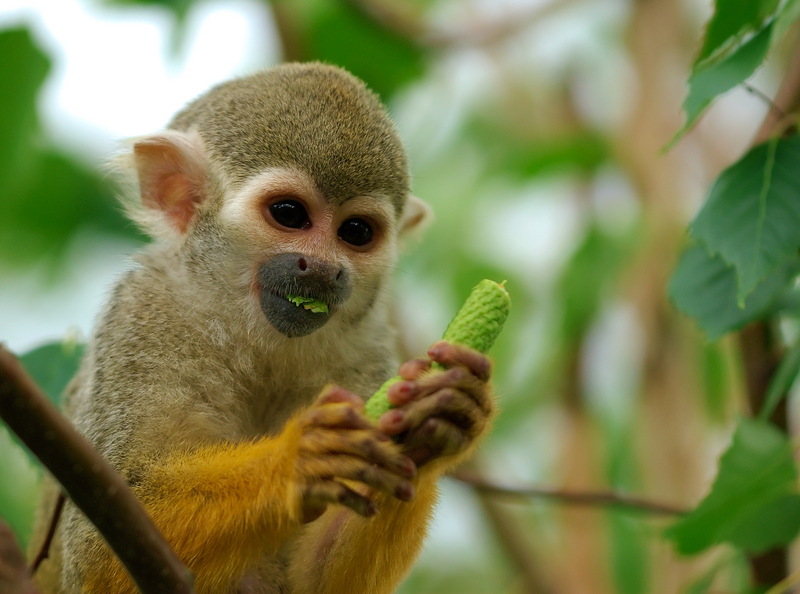|
| Query: Squirrel monkey | Result: 4th of 109 | |
Squirrel Monkey (Family: Cebidae, Genus: Saimiri) - Wiki
| Subject: | Squirrel Monkey (Family: Cebidae, Genus: Saimiri) - Wiki
| |

| Resolution: 2864x2127
File Size: 1728802 Bytes
Date: 2007:05:12 17:09:57
Camera: NIKON D80 (NIKON CORPORATION)
F number: f/2.8
Exposure: 1533917/536870912 sec
Focal Length: 150/1
Upload Date: 2007:10:09 01:05:33
|
Squirrel monkey
From Wikipedia, the free encyclopedia
[Photo] Common Squirrel Monkey, Saimiri sciureus. Source (www.lucnix.be). Camera: Nikon case D80 optical Sigma 150mm F2,8 Macro. Date 2007. Author Luc Viatour (http://commons.wikimedia.org/wiki/User:Lviatour) Copyright (C) 2007 Luc Viator
Permission is granted to copy, distribute and/or modify this document under the terms of the GNU Free Documentation License, Version 1.2 or any later version published by the Free Software Foundation; with no Invariant Sections, no Front-Cover Texts, and no Back-Cover Texts. A copy of the license is included in the section entitled "GNU Free Documentation License". |
The squirrel monkeys are the New World monkeys of the genus Saimiri. They are the only genus in the subfamily Saimirinae.
Squirrel monkeys live in the tropical forests of Central and South America. Their range extends from Costa Rica through central Brazil and Bolivia.
Squirrel monkey fur is short and close, colored olive at the shoulders and yellowish orange on its back and extremities. Their throat and the ears are white and their mouths are black. The upper part of their head is hairy. This black and white face gives them their German name, "skull monkeys".
Squirrel monkeys grow to 25 to 35 cm, plus a 35 to 42 cm tail. They weigh 750 to 1100g. Remarkably, the brain mass to body mass ratio for squirrel monkeys is 1:17, which gives them the largest brain, proportionately, of all the primates. Humans have a 1:35 ratio.
Female squirrel monkeys have a pseudo-penis that they use to display dominance over smaller monkeys, much like the way the male squirrel monkeys display their dominance.
Like most of their New World monkey relatives, squirrel monkeys are diurnal and arboreal. Unlike the other New World monkeys, their tail is not used for climbing, but as a kind of "balancing pole" and also as a tool. Their movements in the branches are extremely speedy.
They live together in multi-male/multi-female groups with up to 500 members. These large groups can, however, occasionally break into smaller troops. They have a number of vocal calls, including warning sounds to protect themselves from large falcons, which are a natural threat to them. Their small body size also makes them susceptible to predators such as snakes and felids. For marking territory, squirrel monkeys rub their tail and their skin with their own urine.
Squirrel monkeys are omnivores, eating primarily fruits and insects. Occasionally they also eat nuts, buds, eggs and small vertebrates.
The mating of the squirrel monkeys is subject to seasonal influences. Females give birth to young during the rainy season, after a 150- to 170-day gestation. The mothers exclusively care for the young. Saimiri oerstedti are weaned by 4 months of age, while S. boliviensis are not fully weaned until 18 months old. Female squirrel monkeys reach sexual maturity at age 3 years, while males take until age 5. They live to about 15 years old in the wild, about 20 years in captivity.
Three squirrel monkey species are in danger of extinction. S. o. oerstedti is listed as "endangered," S. o. citrinellus is listed as "critically endangered" and S. vanzolinii is listed as "Vulnerable."
Classification
Genus Saimiri
S. sciureus group
Central American Squirrel Monkey, Saimiri oerstedii
Black-crowned Central American Squirrel Monkey, Saimiri oerstedii oerstedii
Grey-crowned Central American Squirrel Monkey, Saimiri oerstedii citrinellus
Common Squirrel Monkey, Saimiri sciureus
Saimiri sciureus sciureus
Saimiri sciureus albigena
Humboldt's Squirrel Monkey, Saimiri sciureus cassiquiarensis
Ecuadorian Squirrel Monkey, Saimiri sciureus macrodon
Bare-eared Squirrel Monkey, Saimiri ustus
S. boliviensis group
Black-capped Squirrel Monkey, Saimiri boliviensis
Bolivian Squirrel Monkey, Saimiri boliviensis boliviensis
Peruvian Squirrel Monkey, Saimiri boliviensis peruviensis
Black Squirrel Monkey, Saimiri vanzolini
http://en.wikipedia.org/wiki/Squirrel_monkey
| The text in this page is based on the copyrighted Wikipedia article shown in above URL. It is used under the GNU Free Documentation License. You may redistribute it, verbatim or modified, providing that you comply with the terms of the GFDL. |
|
Comments |
|---|
| | kashui |
|
| its the cutist animal eeeeeeeeeeeeeeeeeeeeevvvvvvvvvvvvvveeeeeeeeeeerrrrrrrrrrrrr |
| | nicole |
|
| i want one these are sooo soo cute!!!! |
^o^
Animal Pictures Archive for smart phones
^o^
|
|
|

